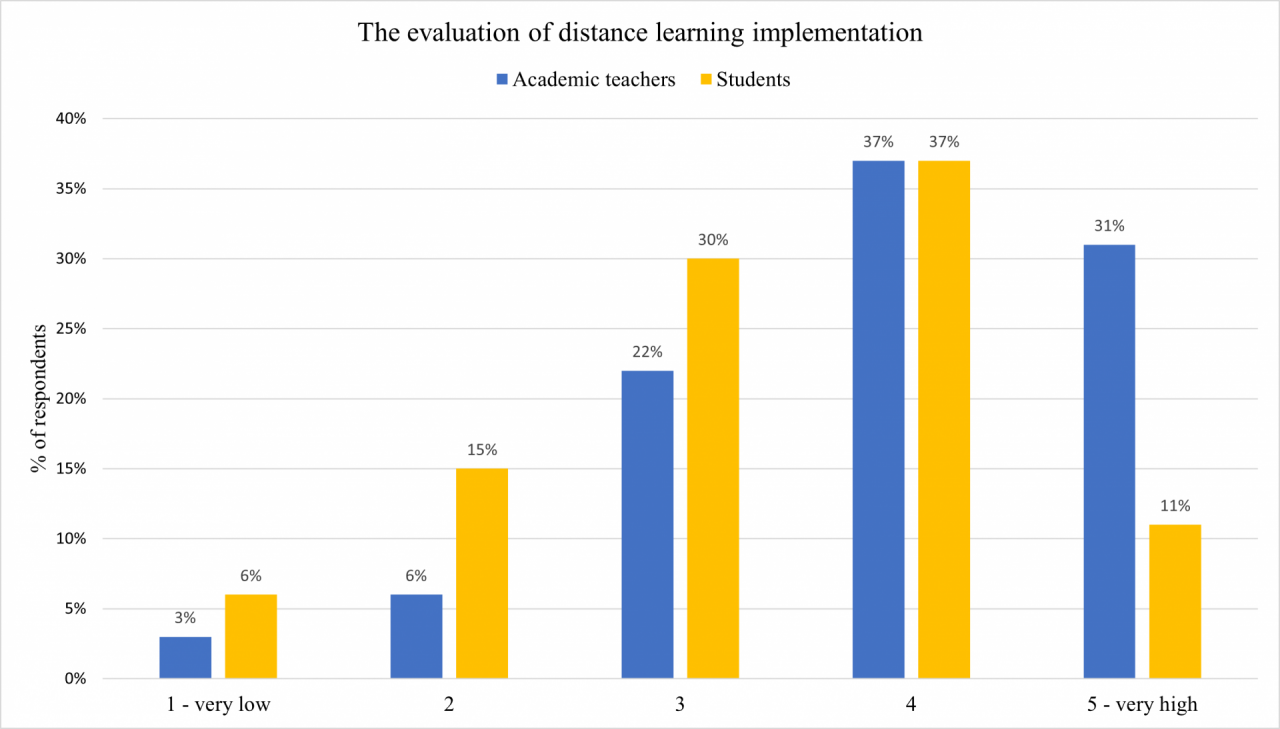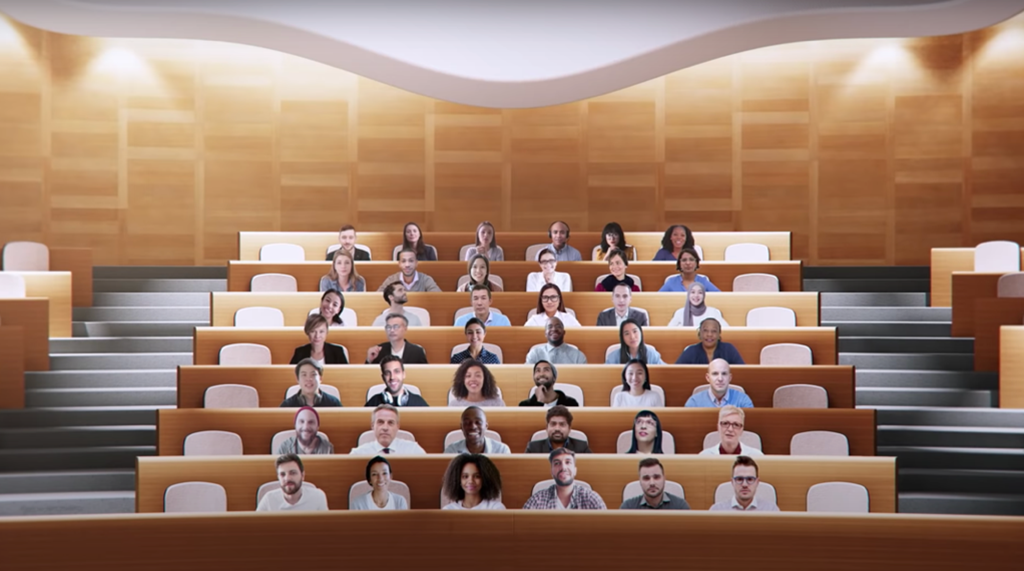
Find out more

Read the article

Find out more

Read the article

Find out more

As a result of the changes caused by the pandemic, many students and lecturers have faced increasing personal, professional and social issues.
The aim of this article is to present selected issues of distance learning at the university level in the Covid-19 pandemic situation from a lecturer’s perspective. As a result, there may be better understanding between teaching staff and students. The article is based on the analysis of the literature on the subject and the results of participant observation, as well as a survey conducted by the Jagiellonian University Competency Development Office in which academic staff and students evaluated various aspects of distance learning offered by the Jagiellonian University during the pandemic2.
These studies revealed differences between students and lecturers of the Jagiellonian University in their overall evaluation of the implementation of distance learning (Figure 1).
Academic teachers indicated a significantly higher workload during distance learning in comparison with traditional classes (the average value indicated by lecturers was 4.8 on a 5-point scale). Apart from teaching, the most time-consuming tasks included the preparation of materials, checking homework, designing assignments and online classes, the award of credits, as well as individual consultations, learning to use remote work tools and reporting on remote classes to the supervisor3. Other problems encountered during online education, indicated by both lecturers and students, included: no possibility to conduct practical classes, difficulty with interactions with the participants of the classes and problems with concentration during the classes4.
Technologies and tools used for remote work in the pre-pandemic era proved to be insufficient for online learning activities with numerous groups where the participants needed to perform many tasks going beyond a video conference. Developers of programmes, portals and applications had to respond quickly to the increased needs of users, improving existing features and introducing new ones to enhance efficiency and the well-being of participants in online meetings and classes. An example of this, based on years of research into digital communication, behaviour in virtual spaces and the use of artificial intelligence, is the introduction of an option in MS Teams called ‘Together Mode’5. It enables the participants to view the meeting as if they were in one room, e.g. in a lecture hall (Fig. 2). Such a solution seems to be much better from a lecturer’s perspective than the option available so far, i.e. the one of impersonal icons with the participants’ initials on the screen.

In order to use remote teaching tools in an optimal way, one needs to know them well and keep up with new developments. At universities, including the Jagiellonian University, both lecturers and students may receive training in the use of platforms and applications intended for online classes. Taking part in such a training session is not only a necessity but also an opportunity to acquire and expand one’s own skills regarding the use of a technology which is and will remain an inseparable element of education and professional work.
In the situation of the limitations imposed because of the Covid-19 pandemic, which changed, among others, the organisation of academic classes, interpersonal competences seem to be more important than the digital competences acquired. Mutual understanding between lecturers and students makes it possible to achieve a balance in terms of communication and knowledge transfer.
1 C. Rapanta, L. Botturi, P. Goodyear, L. Guàrdia, & M. Koole, (2020). Online University Teaching During and After the Covid-19 Crisis: Refocusing Teacher Presence and Learning Activity. Postdigital Science and Education, p. 1
2 Badanie Nauczycieli Akademickich: Ewaluacja Zdalnego Nauczania, Barometr Satysfakcji Studenckiej (moduł: zdalne nauczanie), Raport 2019-2020, Jagiellonian University Competency Development Office, https://jakosc.uj.edu.pl/raport-zn-2020-pelny [access date: 20 September 2020]
3 Ibidem
4 Badanie Nauczycieli Akademickich: Ewaluacja Zdalnego Nauczania, Barometr Satysfakcji Studenckiej (moduł: zdalne nauczanie), Raport 2019-2020, Jagiellonian University Competency Development Office, https://jakosc.uj.edu.pl/raport-zn-2020-pelny, [access date: 20 September 2020]
5 S. Ray (2020), Video fatigue and a late-night host with no audience inspire a new way to help people feel together, remotely, Microsoft/Innovation Stories, https://news.microsoft.com/innovation-stories/microsoft-teams-together-mode/, [access date: 25 September 2020]
Badanie Nauczycieli Akademickich: Ewaluacja Zdalnego Nauczania, Raport 2019-2020, Jagiellonian University Competency Development Office, https://jakosc.uj.edu.pl/raport-zn-2020-pelny [access date: 20 September 2020]
Barometr Satysfakcji Studenckiej (moduł: zdalne nauczanie), Raport 2019-2020, Jagiellonian University Competency Development Office, https://jakosc.uj.edu.pl/raport-zn-2020-pelny [access date: 20 September 2020]
Microsoft 365, Together Mode in Microsoft Teams, https://www.youtube.com/watch?v=MGsNmYKgeTA&ab_channel=Microsoft365
Rapanta, C., Botturi, L., Goodyear, P., Guàrdia, L., & Koole, M. (2020). Online University Teaching During and After the Covid-19 Crisis: Refocusing Teacher Presence and Learning Activity. Postdigital Science and Education, 1- 23. https://doi.org/10.1007/s42438-020-00155-y
Ray S. (2020), Video fatigue and a late-night host with no audience inspire a new way to help people feel together, remotely, Microsoft/Innovation Stories, https://news.microsoft.com/innovation-stories/microsoft-teams-together-mode/, [access date: 25 September 2020]
Aneta Lipińska holds a PhD in humanities in the field of management sciences. She is a lecturer at the Institute of Economics, Finance and Management of the Jagiellonian University in Kraków. Her scientific interests focus on the activity and ecosystem of start-ups, e-business, social media and information society development. Her research as well as teaching and organisational activity at the Jagiellonian University enable her to gain new competencies and combine her passion with professional work.
I like
people liked this article